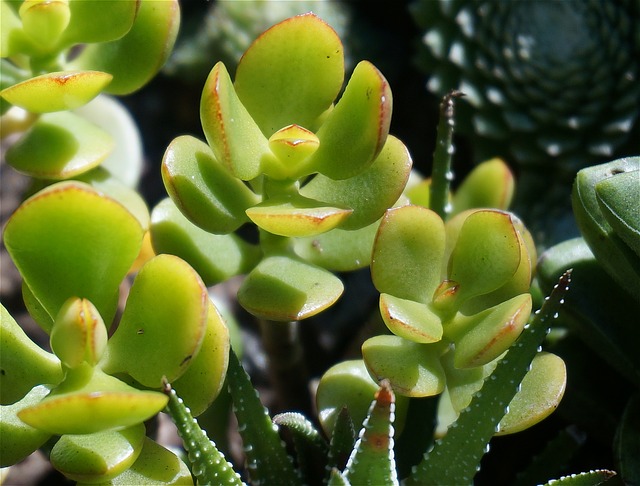Millions of people grow Jade Plants all over the world. Logically, even when we speak about one of the most versatile succulents, when so many people grow it in so many different environments, at least some will experience problems. Some of the most common are Jade Plant growing downward, leaves changing colors to brown, black, red, or even purple, the stem getting mushy, etc. All of these problems are well documented, and while it isn’t always easy to identify the exact cause, we at least know what to do in each instance. However, one problem still remains a mystery to vast majority of Jade Plant growers–crystalizing leaves.
In this post I will try to uncover this mystery, following both the scientific discussion on the subject, and my personal experience with Jade Plants. Let’s start with the basics. Any color or structure changes to leaves of a Jade Plant result from some stress to the plant. Except of minority of leaves turning brown progressively and falling off (yes, Jade Plants do change leaves just like any other plants do), all other changes of color or structure in the leaves indicate something’s wrong with the plant. But what’s wrong when leaves to crystalize? I will try to find the answers on the following lines.
Extreme temperatures and sudden changes in temperature are often to blame
Evidence from fellow growers, as well as my personal experience, suggests that crystalizing of Jade Plant leaves happens most often to plants that are exposed to extreme temperatures, or big temperature changes between day and night. This problem occurs for example when an unexpected heatwave hits some place, and suddenly the indoors temperature grows by five degrees or more in a short span.
It may not look like a big deal to you, I know. But you should realize that a Jade Plant used to certain temperature year round (for example in an air-conditioned apartment) may perceive this as a major change. Plants cannot take off coats and shirts. They react to environmental changes in their own way, and sometimes they may even die. If your plant experiences sort of changes I described, try your best to move it to another place where the temperature and light exposure remains the same.

Evidence suggests combination of extreme sun exposure and over-watering is to blame
Sometimes when we cannot connect the dots scientifically, we look at evidence, and what other growers experienced. From my talks and from stories shared on different online forums, I noticed some pattern. Several people who experienced small crystals and burns on the leaves of their jade plants were actually watering the plant heavily in a dry, super hot season. This step may seem logical, but you should realize that excessive watering is always bad for Jade Plant, regardless of the outside temperature.
I am just speculating now, but I can imagine the excess water almost boiling behind the tissues of leaves, under the immense heat of sun. In such a combination, certain scars can develop on the leaves, and the final effect may resemble small crystals or burns. Keep this on your mind. Regardless of the heat, water your Jade Plant only when the soil is completely dry. You should always use a pot with drainage hole too.
Damaged root system and over-fertilization seems like a likely cause
You know how it goes with both people and plants: We want to do them good, while in fact we are hurting them with giving them what they do not need. In my experience, a healthy Jade Plant does not need any fertilizing at all. Of course producers of fertilizers with their multi-million dollar marketing budgets will tell you the opposite, but think about it in this way: Succulents are native to semi-desert areas, that means areas of arid soil with little nutrient content. Yet they thrive in such areas… Why would you want to give them something else in your home?
Over-fertilizing can burn the roots, or restrain their capacity to transfer a certain nutrient to the stems and leaves of the plant. And the lack of this one nutrient can result in strange (and almost mysterious) changes in the Jade Plant, such as crystalizing of the leaves. The funny thing is that with succulents, over-fertilization doesn’t necessarily mean using fertilizers too often, such as once in two months. With plants like Jade, it can mean using any fertilizer at all, since it simply isn’t natural for the plant, and in combination with certain soil or other issue, it can eventually kill your plant.
Mystery of crystalized leaves unsolved
I asked two botanists from local University for their opinion, bringing them some photos (from the internet) of crystalized leaves of Jade Plant. Neither of them was able to come with a final verdict. They both said some strange form of stress response is taking place, but that’s something I already knew (sort of). At the end of the day, it seems we won’t be able to decipher this mystery today.
But it doesn’t mean that you cannot solve the problem. Try to avoid fertilizers and do not subject your plant to extreme changes. And always remember that plants do what’s best for them–if they are shedding some leaves, they know what they do. Sure, it doesn’t look nice if the leaves are crystalized, but as long as we speak about minority of leaves and the rest of the plant seems just fine, I think you should simply take the recommended precautions and go on with your succulents. Hope it helps, and let me know if you come with some discovery to resolve this mystery…
May also interest you:
